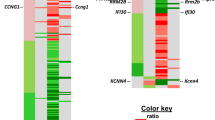Abstract.
Recent in vivo and in vitro data of patients analyzed for genetic susceptibility to radiation during cancer therapy have shown structural changes in the chromosomes to be prevalent both in the patients being treated and in their immediate family members. As structural changes in chromosomes frequently lead to activation of proto-oncogenes and elimination of tumor-suppressor genes, they represent important mechanisms for the initiation of DNA repair processes and tumorigenesis. With the exception of rare genetic syndromes such as AT (Ataxia telangiectasia) or NBS (Nijmegen Breakage Syndrome), the background for the inheritance of genetic susceptibility to radiation is unknown.
Recently, a large-scale genetic screen of mouse mutants has been established within the German Human Genome Project (Hrabè de Angelis and Balling 1998). The goal of this ENU (ENU: ethylnitrosourea) mutagenesis screen is the generation of mutant mice that will serve as animal models for human diseases and genetic susceptibility.
In order to fully utilize the potential of a genetic screen of this magnitude, in which exploration for genes responsible for genomic instability and radiation sensitivity is to occur, it is necessary to establish a simple assay system that is amenable to automation. Hence, we are using the single-cell gel electrophoresis (comet assay) to detect mouse mutants that display a genetic susceptibility to ionizing radiation. We have established the analysis parameters in the comet assay which are currently used to detect radiation-sensitive mouse mutants and to control the variance within the mouse population in the ENU screen. The assay can be used to isolate genes that are responsible for DNA repair and radiation sensitivity in mouse and human.
Similar content being viewed by others
Author information
Authors and Affiliations
Additional information
Received: 16 December 1999 / Accepted: 17 December 1999
Rights and permissions
About this article
Cite this article
Schindewolf, C., Lobenwein, K., Trinczek, K. et al. Comet assay as a tool to screen for mouse models with inherited radiation sensitivity. Mammalian Genome 11, 552–554 (2000). https://doi.org/10.1007/s003350010106
Published:
Issue Date:
DOI: https://doi.org/10.1007/s003350010106




